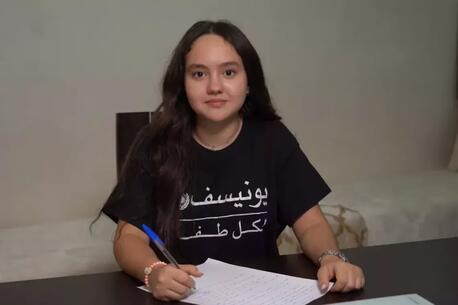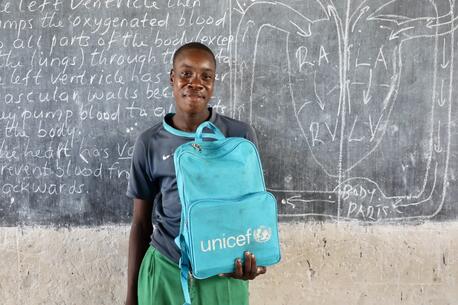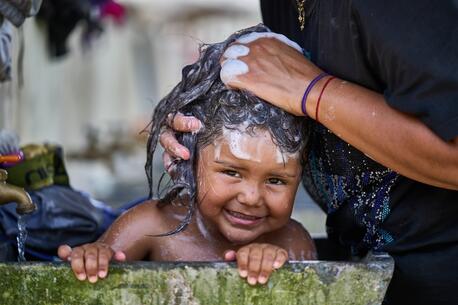
UNICEF in Panama
The number of migrants arriving in Panama — including unaccompanied and separated children — has surged in 2024, creating challenges for indigenous host communities. UNICEF continues to respond for children and families on the move throughout their journeys. Learn more, including how to help.
Crisis in Panama
Panama is the epicenter of one of the Western Hemisphere’s largest humanitarian crises, as hundreds of thousands of migrants from Venezuela, Ecuador, Brazil, Chile and Haiti — half of them children and babies — pour across its eastern border through a vast and perilous wilderness area known as the Darién Gap.
In the first four months of 2024, more than 30,000 children crossed the Darién Gap, a 40 percent increase compared to the same period last year.
“Women have given birth while en route, bringing new life into the world in the most challenging of circumstances,” UNICEF Deputy Executive Director Ted Chaiban said. “Many of those who survive the journey arrive sick, hungry, and dehydrated, often with wounds or infections and in desperate need of support.”
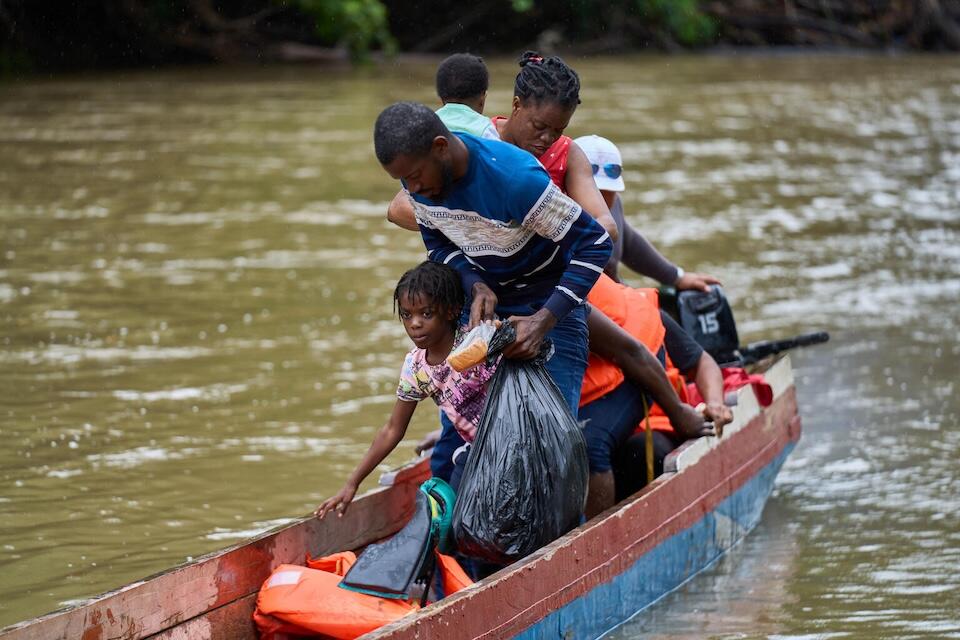
The migrant influx, which some estimate could reach as high as 800,000 people — including 160,000 children and adolescents — by the end of 2024,is straining the resources of a nation that has among the highest levels of economic inequality in the region.
And it adds another dimension to the challenges already facing the nation’s youth. Panama is home to 1.3 million children, about 30 percent of the population. Three out of every 10 children in the country live in poverty. Some 16 percent of children under age 5 are affected by stunting. An estimated 40 percent of children have experienced violent discipline, and 64 percent of all cases of sexual violence are against children and adolescents.
The quality of education in Panama is among the worst in Latin America and the Caribbean, by some measures, with groups suffering from exclusion (such as Indigenous children) showing significantly lower achievement rates in literacy and numeracy.
How UNICEF is helping children on the move in Panama
UNICEF staff have been supporting children on the move in the Darién Gap and in Panama since 2018, delivering services at hot spots along the migration route including water, sanitation and hygiene (WASH), child protection and case management aimed at promoting child and maternal health and combatting gender-based violence.
That mission is more urgent than ever. As the number of children crossing the Darién Gap by foot has exploded, the number of unaccompanied or separated children has increased five-fold. In the first four months of 2024, nearly 2,000 of those arriving were unaccompanied or separated from their families, triple the number seen during that period last year.
Unaccompanied children are particularly vulnerable to violence, abuse and exploitation.
Even those traveling with parents face dire challenges. Most of the migrant families exiting the Gap, said Garry Conille, UNICEF Regional Director for Latin America and the Caribbean, “have lost everything during the crossing — their belongings, their identity documents, their money; they are left with nothing but the clothes they are wearing. It was heartbreaking to hear these survivors’ stories of hardship.”
This flood of migrants has overwhelmed existing capacity at temporary migrant reception areas in Darién, Panama, at times exceeding shelter capacity by 600 percent. Access to basic services such as drinking water, hygiene, food and medical attention remain insufficient.
To help meet immediate needs in areas of Panama where migrants exit the gap, and to tackle longer-term challenges, UNICEF is:
- scaling up its presence to provide essential services, such as safe water, hygiene and sanitation along with spaces for self-care for women and adolescent girls and services to prevent and respond to gender-based violence
- reaching thousands of children and caregivers every day through Child-Friendly Spaces in migrant reception stations and host communities, offering health services, psychosocial support, child protection and case management
- working with local authorities to identify unaccompanied and separated children, providing information to families about potential risks on the migration route and calling attention to the unprecedented increase in the number of children on the dangerous jungle route and the need for measures to protect them from violence, exploitation and abuse
- collaborating with representatives from the Panamanian and Colombian governments to promote child-friendly national migration policies that ensure legal, orderly and safe migration pathways and more robust humanitarian responses, including additional age-specific health and child protection services and access to essential services such as education and health care
Related: How UNICEF and partners work to protect child refugees and migrants
Addressing inequalities to safeguard child rights in Panama
Panama’s gross domestic product grew by 9 percent in 2022 — among the highest rate of economic growth rate in Latin America. The nation has made significant policy changes in recent years, passing a new law creating a comprehensive child protection system, and making a national commitment to increase GDP to education from 5.4 percent to 6 percent by 2024.
But children living in poverty, indigenous children, Afro-descendant children, those living in rural areas, migrant children, children with disabilities and those without parental care may be excluded from the social safety net. While Panama is a high-income country, its level of economic inequality is one of the highest in the world.
To close these gaps, UNICEF is working closely with government partners to advocate for and help develop policies that ensure better coverage and quality of basic social services.
UNICEF has continued to support efforts to strengthen Panama’s existing social safety net by lobbying for child-friendly legislation and budgets, and supporting trainings for teachers, health care workers and child protection specialists.
Reform of the child protection system is also underway. UNICEF has been helping write policies that will increase surveillance and interventions when children are in danger. UNICEF has also helped to deinstitutionalize children who are without parental care, working to arrange for alternative residential care.
How UNICEF is supporting children's education in Panama
Panama has among the lowest educational outcomes in the region. By some estimates, 84 percent of 15-year-old students did not reach the minimum proficiency in mathematics, and 6 out of 10 students in third grade lack minimum reading skills. Outdated curriculum, insufficient training for teachers, and low investment are largely to blame.
UNICEF is helping to address these issues in collaboration with Panama's Ministry of Education. Efforts include:
- developing an early warning system in schools aimed at preventing school dropout and detecting issues affecting individual children, such as malnutrition or domestic violence, so that teachers can intervene
- developing trainings for pre-primary and primary teachers designed to teach them nurturing and sensitive care, positive discipline in the classroom, play-based learning and skills that foster collaboration with caregivers
- helping to assess gaps in teacher training and to formulate an improvement plan, sharing internationally recognized best practices
A new program designed to increase the foundational skills of all primary and lower secondary students, entitled ‘Aprender es mi derecho’ (‘Learning is my right’), has already provided trainings to hundreds of schoolteachers who learned how to improve the reading and writing skills of their students.
How UNICEF is promoting children's health in Panama
In the area of children's health, in partnership with the government, UNICEF is:
- helping to identify access barriers to primary health care in underserved areas of the nation
- collaborating on the design and implementation of a new model for monitoring and managing childhood illness and nutrition
- working to improve access to adolescent-friendly health services at the community level, by training community health workers in remote and hard-to-reach communities
- supporting efforts to better monitor the quality of newborn care
- helping to develop a national action plan to address obesity and malnutrition in children and adolescents
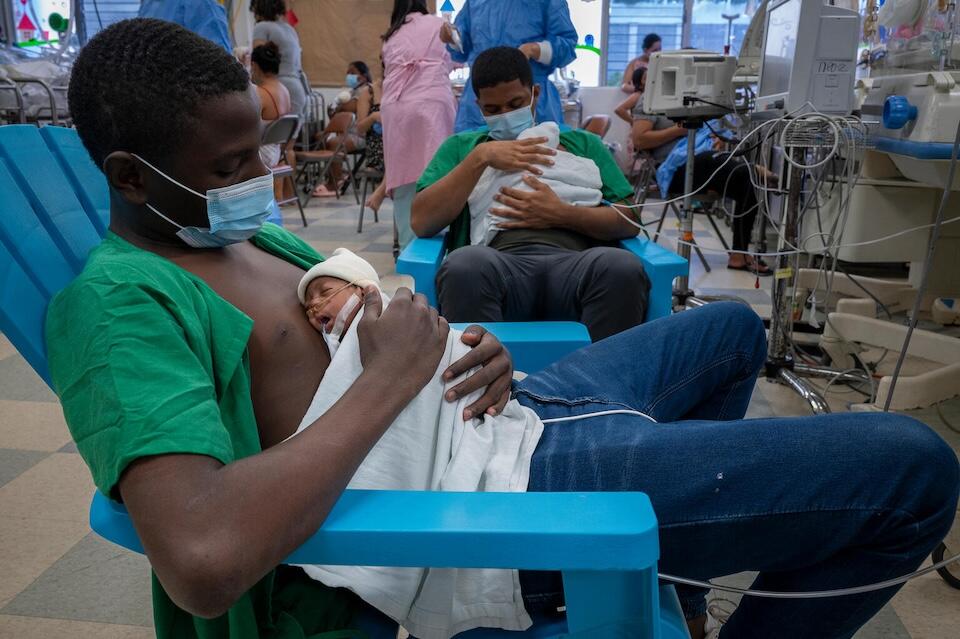
UNICEF also supports programs aimed at new mothers that emphasize healthy practices — such as breastfeeding — known to give babies their best start in life.
The Kangaroo Family Care program, which UNICEF is helping to implement at several public hospitals in Panama, promotes using skin-to-skin contact – usually a parent’s own body – to warm and nurture a newborn baby, in particular pre-term and low birth weight infants. Kangaroo Care has been proven to reduce neonatal mortality, promote the parent-child bond and support physical, cognitive and emotional development.
UNICEF works in over 190 countries and territories to create a more equitable world where children are healthy, educated, protected and respected. Learn more about what UNICEF does and how to support UNICEF's global mission by becoming a monthly donor.
